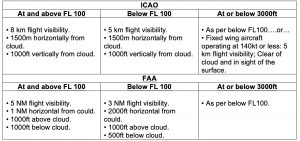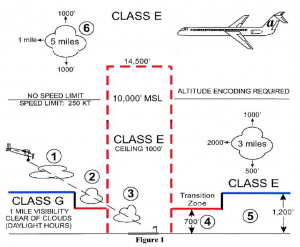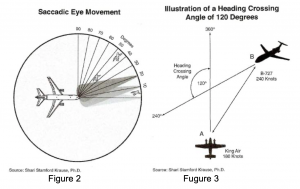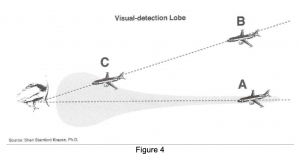55TH ANNUAL CONFERENCE, Las Vegas, USA, 14-18 March 2016WP No. 310Separation in Class E AirspacePresented by PLC |
Summary
Class E Airspace is the lowest class of controlled airspace. Controlled doesn’t mean visual flight rules (VFR) traffic has to be in radio contact with air traffic control (ATC), but that ATC services are available within the capabilities of radar and radio equipment. Instrument flight rules (IFR) traffic is required to contact ATC for a clearance. This is general-purpose airspace and aircraft flying under VFR can fly more-or-less wherever they want (weather permitting) and IFR traffic operates under positive control by ATC. There are regulations in this airspace but they aren’t onerous, and they’re designed to accommodate the variety of aircraft and activities that can be found here. Although Class E airspace is a single class of airspace, there are tighter regulations above 10,000 feet, where there are no airspeed restrictions (other than the prohibition on supersonic flight over land) compared to lower altitudes where airspeeds are limited to 250 knots.
Introduction
1.1. This paper was requested by Germany at the 2015 Conference in Sofia. The purpose of this paper is to look at Class E Airspace: who is responsible for separation and what would the legal implications be in the event of an incident or accident that occurred in Class E Airspace.
1.2. Airspace is an area of aeronautical knowledge that is commonly poorly demonstrated in practical tests. Even when pupil pilots demonstrate knowledge of the airspace system that meets the minimum standard necessary for issuance of a pilot certificate or rating, it is usually clear that this knowledge level has been achieved by simple memorisation without understanding the underlying concepts.
1.3. Consequently, it is not surprising that pilots, especially those flying recreational, are often found to be confused about this subject. This observation is supported by the fact that airspace violations remain a major cause of actions taken against offending members of the general aviation community.
Discussion
2.1. IFATCA Policy
2.1.1. According to the IFATCA Technical & Professional Manual (2015), in 1991 in an attempt to harmonise the categories of airspace, ICAO re-classified the airspace offering seven different types. Since then, no review has taken place with regard to whether this re-classification has created a harmonised situation. There is now evidence to suggest, that there is a lack of harmonisation between neighbouring countries, and that there exists a degree of under and over classification.
2.1.2. IFATCA policy is:
| ATS Authorities are urged to co-ordinate and harmonise with all neighbouring states their national airspace classification to permit safe and efficient operating conditions to all airspace users and air traffic controllers. Airspace classification should be appropriate for the traffic operating in the airspace, to avoid over and under classification. As traffic situations change, the classification may have to change accordingly.
With regard to the ICAO classification of airspace, the definition of controlled airspace is the generic term which covers airspaces of class A, B, C and D. Classes E, F and G being uncontrolled. Class E is a special case of uncontrolled airspace in which a limited Separation service will be provided between defined aircraft. |
(IFATCA Technical & Professional Manual, 2015, “ATS 3.3 Harmonisation of the Airspace Classification”, page 3 2 3 4)
2.2. The ICAO Airspace Classification System
2.2.1. According to International Civil Aviation Committee Study Guide (2015), on March 12 1990, ICAO adopted the current airspace classification scheme. The classes are fundamentally defined in terms of flight rules and interactions between aircraft and ATC. Generally speaking, the ICAO airspaces allocate the responsibility for avoiding other aircraft, either to ATC or to the aircraft commander.
2.2.2. The ICAO Airspace Classification System (ICAO Annex 11 to the Convention on International Civil Aviation, Thirteenth Edition July 2001 – “Air Traffic Services” Chapter 2 page 2-4) consists of seven classes of airspace, each specifying minimum Air Traffic Service requirements and the services provided. Classes A, B, C, D & E are Controlled Airspace whilst Classes F & G Airspace is Uncontrolled Airspace.
2.2.3. In Class E Airspace IFR and VFR flights are permitted, IFR flights are provided with air traffic control service and are separated from other IFR flights. All flights receive traffic information as far as is practical. Class E Airspace shall not be used for control zones.

2.2.4. Where the ATS airspaces adjoin vertically, i.e. one above the other, flights at a common level would comply with requirements of, and be given services applicable to, the less restrictive class of airspace. In applying these criteria, Class B airspace is therefore considered less restrictive than Class A airspace; Class C airspace less restrictive than Class B airspace, etc.
2.3. Separation of Traffic in Class E Airspace
2.3.1. Controlled airspace: An airspace of defined dimensions within which air traffic control service is provided in accordance with the airspace classification.
2.3.2. Separation of air traffic, and the methods of separation, is the key to the organisation of the airspace system. Consequently, understanding these separation concepts is crucial to complete an understanding of Airspace Classifications.
2.3.3. Aircraft that are being operated under Instrument Flight Rules (IFR) are separated from other IFR aircraft by Air Traffic Control Officers (ATCOs). ATCOs are charged with the responsibility to maintain a distance between these aircraft of (usually) five miles laterally, and 1000 feet vertically. These distances can be slightly decreased by the appropriate authority in some areas.
2.3.4. Aircraft that are being operated under Visual Flight Rules (VFR) are separated from all other aircraft visually. Pilots of these aircraft are charged with the responsibility of maintaining “see and avoid” vigilance as a collision avoidance technique. When an aircraft that is being operated under IFR is in visual meteorological conditions (VMC), the pilot of that aircraft is also required to maintain visual separation from other aircraft.
2.3.5. The ICAO airspace rules for Class E are clear. PLC has found no specific cases in which the separation rules were found not to be clear, leading to liability issues.
2.4. Airspace Classification
2.4.1. Consequently, if airspace is not Class A, B, C, or D, and is controlled airspace it is Class E airspace. There are no specific pilot certification or equipment requirements to operate in Class E airspace. Special VFR operations are permitted but clearance must be obtained from the controlling facility.
2.4.2. Class A Airspace has the lowest risk and Class E has the highest risk of all the controlled airspaces on the ICAO Airspace Classification System.
2.4.3. Class E Airspace requirements add a layer of restrictions to those that define Class G Airspace. As stated previously, Air Traffic Control (ATC) provides positive separation between all aircraft being operated under IFR. VFR pilots provide their own separation using see and avoid procedures. Very important to remember is a pilot operating under IFR is not relieved of the responsibility of exercising see and avoid separation when weather conditions allow it. This becomes complicated when an IFR aircraft emerges from a cloud and suddenly transitions to visual separation. Both IFR and VFR pilots require some protection to increase their reaction time to deal with this transitional moment.
2.4.4. In Class E airspace, traffic information is mainly based on radar information derived from SSR replies.
2.4.5. An ATCO separating IFR from IFR in class E airspace is not responsible for separation with VFR traffic, he will only give traffic information as far as practical. The traffic may not be known/visible to the ATCO or there are other priorities in busy moments this means the see and avoid principle will always be leading for both VFR and IFR pilots when operating in class E airspace.
2.5. Weather Minima
2.5.1. Class E Airspace rules provide that protection. If a pilot operating an aircraft under VFR wants to enter Class E Airspace with IFR aircraft, he has to maintain a safe distance from clouds as prescribed in the VFR table below for ICAO and FAA weather minima.

2.6. Weather Minima Practical Example FAA

2.6.1. Consider the aircraft executing the instrument approach in Figure 1. Class E Airspace rules provide separation when it emerges from the cloud at area 1. As the aircraft nears the vicinity of the airport, the floor of Class E Airspace is lowered so that separation protection is maintained when it flies out of the cloud at area 2. If the instrument approach being flown is a non-precision approach, this is the approximate minimum descent altitude. If the aircraft is established on a precision instrument approach (which usually terminates at an altitude of approximately 200 feet AGL), then Class E Airspace is extended to the surface so that the flight is protected when it emerges from the cloud at area 3. The dimensions of the Control Zone, where Class E Airspace exists at the surface, (this is not ICAO compliant) is a 5 statute mile radius from the center of the airport, and vertically from the surface to 14,500 feet MSL. VFR flight within this Control Zone requires, in addition to the normal Class E visibility and cloud clearances, a minimum ceiling of 1,000 feet (ceilings are always expressed in AGL).
2.6.2. At an altitude of 10,000 feet MSL, there is a fundamental change in airspace rules that necessitates a shift in Class E and Class G airspace visibilities and cloud clearances. Below 10,000 feet MSL, a speed limit of 250 knots is imposed on all aircraft flying in that airspace. Above 10,000 feet MSL, pilots of all aircraft are allowed to operate at any subsonic speed. Since high-performance IFR aircraft are emerging from clouds at much higher airspeeds (Figure 1, area 6), Class E required inflight visibility is increased to 5 statute miles, and cloud clearances are increased to 1000 feet above and below clouds and 1 statute mile horizontally. (Class G visibility and cloud clearances are also increased, although no IFR aircraft should normally be operating in this airspace.)
2.6.3. The red shaded area (4) represents the Transition Zone and encloses an area in which Class G Airspace extends from the surface up to 700 feet AGL. (Note that transitions zones may contain extensions to accommodate the requirements of instrument approach procedures.) Outside the shaded magenta line, area (5), Class G Airspace extends from the surface to 1,200 feet AGL. Area (3), which is enclosed by a dashed magenta line, depicts Class E airspace that extends all the way to the surface. The presence of this dashed magenta line, formerly called a Control Zone, indicates that this airport offers a precision instrument approach, which normally provides IFR separation down to 200 feet AGL.
2.6.4. Most general aviation airports offer only non-precision instrument approaches. These approaches only allow IFR aircraft to descend to minimum descent altitude that is approximately the same as the top of the transition zone.
2.6.5. In summary, Class E Airspace rules are more restrictive that those that govern Class G Airspace, but only in terms of required minimum visibilities and cloud clearances necessary to accommodate the separation of IFR and VFR aircraft. There is still no requirement for electronic communication or navigation equipment or its use. The only requirement of this type is the requirement of an altitude- encoding transponder for flight above 20,000 feet MSL.
2.7. What is an airspace infringement?
2.7.1. A flight into a notified airspace that has not been subject to approval by the designated controlling authority of that airspace in accordance with international and national regulations. Such airspace is considered to be:
Controlled airspace, including ICAO airspace classes A to E.
Note: VFR traffic cannot infringe Class E airspace because under ICAO rules neither an ATC clearance nor a radio communication is required to enter or operate within it, unless filed national differences call for one or the other (or both). IFR traffic can infringe Class E airspace when not in receipt of a clearance to enter it.
2.8. Class of Airspace and Air Crew Awareness Limits
2.8.1. Looking at some Incident and Accident investigations, there is a clear indication that there are many contributing factors and misconceptions:
- Infringements occur not only in General Aviation;
- Early descent scenario where aircraft is cleared to descent, too soon to final
- descent altitude;
- Visual approach scenario leading to flight path that could conflict with
- secondary runway circuit dedicated to GA;
- Crew not always aware of mixed IFR/VFR traffic airspace (Class E);
- Airport or runway confusion.
2.8.2. In France, a mid-air collisions occurred on 12 February 1999, between a Grob 103 C glider and an A320 airliner. The glider was in wave flight at FL 80 and an Airbus A320 on approach to Montpellier airport. Following this mid-air collision, certain clubs and organisations began to install reflective strips on gliders. This equipment was then made mandatory for certain French gliding events.
2.8.3. The Mid Air Collision Case between an A320 and a Glider.
Type of airspace successively crossed during A320 arrival:
- From cruise to initial descent: class A controlled airspace.
- Descending below FL195: class D controlled airspace.
- Passing FL115: class G uncontrolled airspace.
- The mid air collision occurred at at FL80 in this class G airspace.
- Minutes after the collision: class D controlled airspace.
- Descending through 5700 ft: class E controlled airspace.
- At about 4900 ft: class D, destination airport.
- Then the A320 flew until landing in this class D controlled airspace.
2.8.4. It is difficult for a pilot to constantly be aware of the types of airspace crossed while preparing for an approach and looking outside in compliance with the “see and avoid” rule.
2.8.5. “See and Avoid” is recognised as a method for avoiding collision when weather conditions permit and requires that pilots should actively search for potentially conflicting traffic, especially when operating in airspace where all traffic is not operating under the instructions of ATC.
2.8.6. “See and Avoid” is included by the US Federal Aviation Administration (FAA) in Regulation 14 CFR Part 91.113 (b) as follows:
“When weather conditions permit, regardless of whether an operation is conducted under instrument flight rules or visual flight rules, vigilance shall be maintained by each person operating an aircraft so as to see and avoid other aircraft. When a rule of this section gives another aircraft the right-of-way, the pilot shall give way to that aircraft and may not pass over, under, or ahead of it unless well clear.”
2.8.7. “See and Avoid” requires the application of:
- Effective visual scanning;
- The ability to gather information from radio transmissions from ground stations and other aircraft;
- Situational Awareness, and
- The development of good airmanship.
2.8.8. The high speed of modern commercial aircraft has called into question the adequacy of the “see and avoid” principle for such traffic and an article published over 10 years ago by the Flight Safety Foundation (Flight Safety Digest – Collision Avoidance must go beyond “See and Avoid” to “Search and Detect” – May 1997) questions its relevance. “See and Avoid” principal is rarely found in the Operating Procedures of most air carriers since they operate mainly in Controlled Airspace. However, it is important, especially in Class E controlled airspace where ATC does not provide separation to VFR traffic.
2.9. Pilot eye limitations
2.9.1. In the absence of a visual stimulus (for example, empty airspace), the muscles in the eye relax, preventing the lens from focusing. This creates a problem for a pilot who is attempting to scan for traffic in a clear, featureless sky. Because the eye cannot properly focus on empty space, it remains in a state of unfocused, or blurred, vision. This phenomenon, known as “empty-field myopia,” hinders effective search and detection.

2.9.2. Another aspect of eye functioning that is relevant to visual searching is saccadic eye movement. When they are not tracking a moving target, the eyes do not shift smoothly, they shift in a series of jerky movements or “jumps” called saccades (Figure 2). As a result of saccadic eye movements, it is not possible to make voluntary, smooth eye movements while scanning featureless space.
2.9.3. Visual acuity is greatest for objects that are directly in front of the eye. But the fovea is a mere two degrees wide, which results in a very narrow high-acuity detection area and leaves as much as 178 degrees of the detection area in the realm of peripheral vision. This is one reason that we often tend to spot traffic or obstacles out of the “corner” of our eye.
2.9.4. A 120-degree heading-crossing angel (Figure 3) provides a larger cross section of the target aircraft and thus a higher probability of detection than in a head-on meeting between the same two aircraft.
2.9.5. As Figure 4 (below) illustrates, the detection range for central vision is narrow but extends relatively far, whereas the detection range for peripheral vision includes a wider area but extends a much shorter distance. The visual-detection lobe represents the range in which detection is probable, not certain.

2.9.6. The shaded areas in Figure 4 depict how the visual-detection lobe relates to saccadic eye-movement scans. Compared to near searches, distant searches using central vision must be scanned over a much larger field in a relatively short period of time.
2.9.7. In Figure 4, the same type of aircraft is shown in the three positions – A, B and C. Aircraft A, in the central field of vision, is likely to be detected. Aircraft B, although it is at the same range as Aircraft A, is outside the visual-detection lobe and unlikely to be detected. Aircraft C is the same number of degrees off the direct line of vision as Aircraft B, but because it is within the visual-detection lobe, it is likely to be detected through peripheral vision.
2.9.8. Depending on closure rate, crossing angle and routine cockpit distractions, aircraft can seem to appear suddenly, leaving little time to react and avoid a collision.
Conclusions
3.1. The current ICAO airspace classification scheme was adopted in 1990.
3.2. No concrete evidence could be found to suggest that there is a lack of harmonisation between neighbouring countries or that there is a degree of over and under classification.
3.3. IFATCA policy is incorrect stating that Class E airspace is uncontrolled, it is controlled airspace for IFR traffic and uncontrolled for VFR.
3.4. The ICAO rules pertaining to Class E airspace are clear. As long as ATCO’s comply with these rules the liabilities and responsibilities for separation between IFR and VFR traffic should fall to the pilot in VMC. ATCO’s are not encouraged to give radar headings to IFR traffic to avoid VFR traffic but rather give traffic information, as there might be other VFR traffic in the area that is not known to the ATCO.
3.5. Class E airspace is the highest risk airspace of all the controlled airspaces and was intended that way with the ICAO airspace classification system, this is to give more freedom to the users of Class E airspace.
3.6. There is a weather minima chart to try and mitigate the risk of IFR and VFR traffic sharing Class E airspace.
3.7. It is practically impossible to determine the legal implications in the event of an incident or accident that occurred in Class E Airspace on a global platform. States could assess the situation in a different way and expect controllers to perform in a specific way.
3.8. Pilots experience difficulties to be constantly aware of the type of airspaces crossed while preparing for an approach and looking outside in compliance with the “see and avoid” rule.
3.9. One of the critical safety issues regarding class E airspace is the speed of modern aircraft and the ability of the human eye to detect aircraft in a clear futureless sky.
Recommendations
4.1. It is recommended that; IFATCA policy is:
ATS Authorities are urged to co-ordinate and harmonise with all neighbouring states their national airspace classification to permit safe and efficient operating conditions to all airspace users and air traffic controllers. Airspace classification should be appropriate for the traffic operating in the airspace, to avoid over and under classification. As traffic situations change, the classification may have to change accordingly.
With regard to the ICAO classification of airspace, the definition of controlled airspace is the generic term which covers airspaces of class A, B, C and D. Classes E, F and G being uncontrolled. Class E is a special case of uncontrolled airspace in which a limited Separation service will be provided between defined aircraft.
4.2 Be amended to read:
MA’s shall urge ATS Authorities to co-ordinate and harmonise with all neighbouring states their national airspace classification, in accordance with ICAO Annex 11 Appendix 4, to permit safe and efficient operating conditions to all airspace users and air traffic controllers. Airspace classification should be appropriate for the traffic operating in the airspace, to avoid over and under classification. As traffic situations change, the classification may have to change accordingly. Local operational controllers should be involved in the airspace classification process.
and is included in the IFATCA Technical and Professional Manual, ATS3.3 Harmonisation of the airspace classification, Page 3.2.3.4.
References
Guide to Visual Flight Rules (VFR) in the UK
Airspace Infringements – Background Statistics
Airspace Infringement Risk Airline operators – Airspace Infringement Safety Initiative Workshop – January 2008 – Eurocontrol, HQ, Brussels.
https://www.skybrary.aero/index.php/See_and_Avoid
https://www.westwingsinc.com/AIRSPACE_EXPLAINED.pdf
Flight Safety Digest – Collision Avoidance must go beyond “See and Avoid” to “Search and Detect” – May 1997
Report no F-VG990212 and F-XB990212 concerning the mid-air collision which occurred on 12 February 1999 at Gorniès between an Airbus A320 and a Grob 103 C glider.
International Civil Aviation Committee Study Guide – 2015


